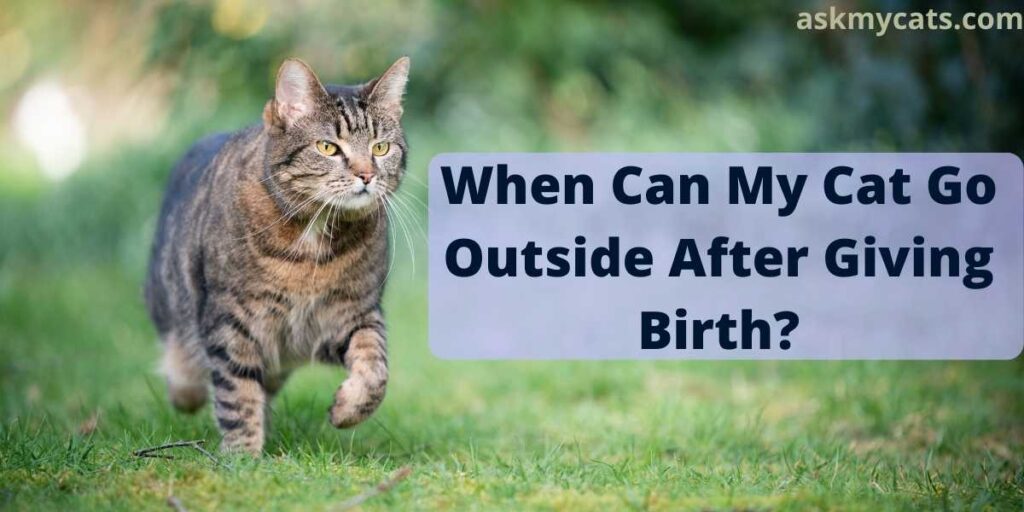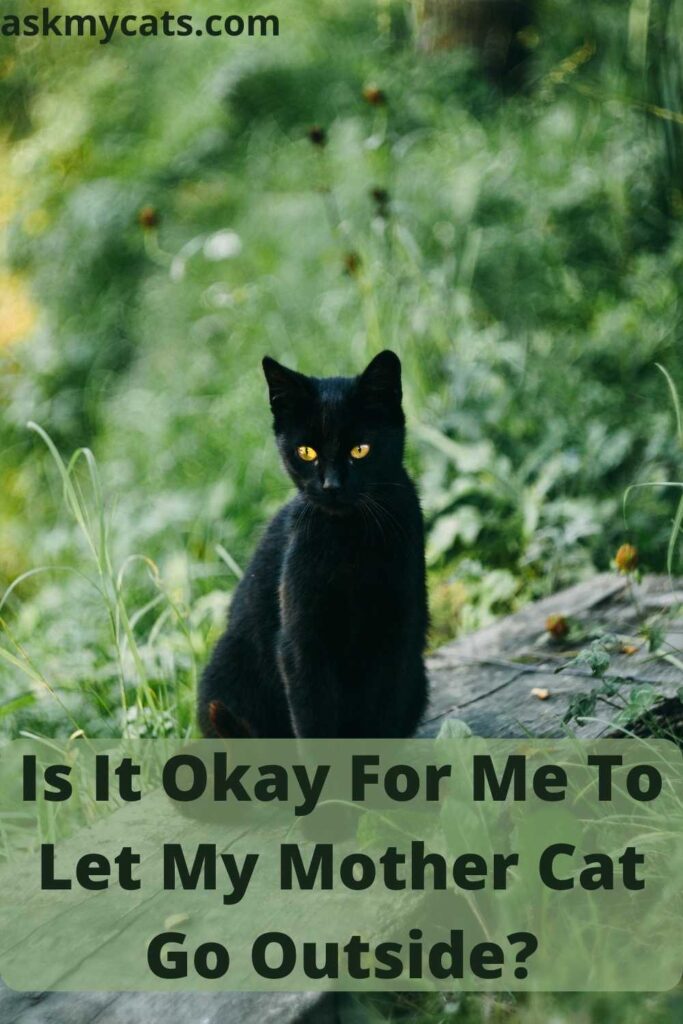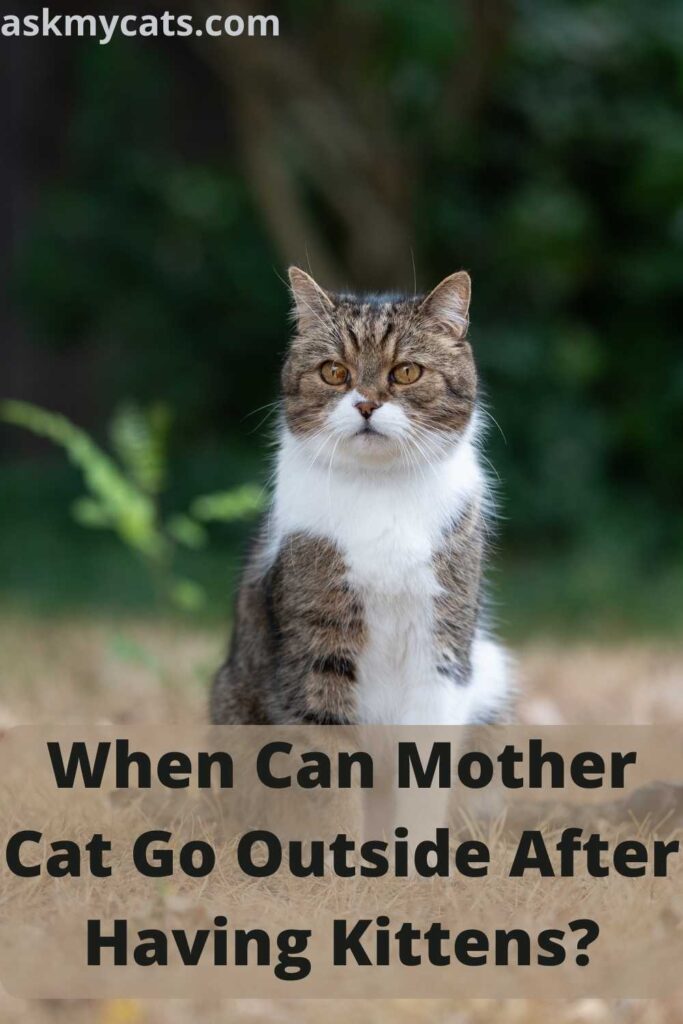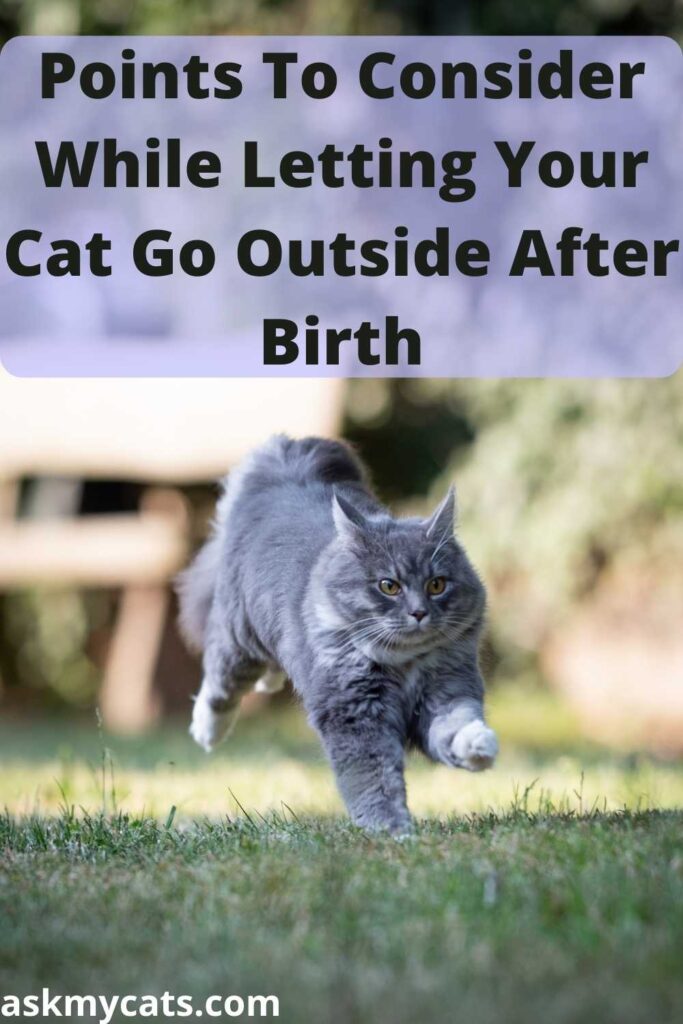A cat that is expecting will follow a set timetable. This frequently depends on the body’s hormones and environment. While caring for a pregnant cat can be difficult, you should also think about what will happen when the baby is born.
So, when can a cat go outside after giving birth?
A cat can go out within 24 hours after giving birth to her kittens. The health of the cat will determine this. The cat may choose to spend time outside immediately soon if its birth is uncomplicated and without difficulties.
Keep reading this article, to know more about when can your cat go outside after giving birth.


Give Your Cat the Perfect Day
Get the Free Ebook!
Is It Okay For Me To Let My Mother Cat Go Outside?
Yes, it is okay for you to let your cat outside, however, you must wait for at least 24 hours.

Cats can venture outside about a week after giving birth, but they must stay indoors for around 24 hours if there are no complications during labor or for a week if there are complications following delivery.
Finding a vet to look for your cat while she recovers from giving birth will be crucial for you.
If the cat’s body temperature is normal, she is ready to go outside once more and needs to feel secure enough to explore your house and the surrounding area on her own.
The cat won’t become pregnant again and won’t go into heat again, therefore there’s no need to vaccinate her once more.
It all comes down to how much you can manage and how comfortable you are in the environment.
When Can Mother Cat Go Outside After Having Kittens?
A mother can go outside as early as 24 hours after giving birth if there is no complication.

The way a cat behaves after giving birth typically depends on how healthy it is.
The cat will probably stay in the same place if it is in pain.
However, there isn’t much of a need to restrain a cat if it is feeling bouncy and has a spring in its step.
Most moms would take short breaks from caring for their kittens to go collect food.
The same logic holds here since a mother cat might feel compelled to go outside and hunt right now.
Checking the cat’s health is therefore the most crucial thing you can do. Just watch it to see how it behaves and moves.
You may let the cat out if it walks with a natural hop and appears to have recovered.
If it’s not absolutely necessary to keep the cat physically healthy, don’t try to prevent them from going outside.
Sometimes allowing a cat outside after it is born will improve its mental health.
As a cat owner, you must take this into consideration.
You may have heard that female cats that are nursing kittens are unable to become pregnant.
Unluckily, this is untrue. If it’s still breeding season, most cats will begin their estrus cycle (also known as their heat cycle) about 4 weeks after weaning their kittens.
She may still be nursing and in heat at the same time.
Estrus is referred to as the time when a female cat is most open to mating and is associated with the ovarian follicles’ production of estradiol, a kind of estrogen.
Although occasionally mucous discharge may be seen, it is not to be confused with menstruation in human females.
You will hardly ever notice any traces of blood throughout this process.
She can be let out as long as she is feeding and caring for them.
An outdoor cat should not stay indoors for more than three weeks, especially since she will no longer be defending her young.
Also, check out how long can a mother cat be away from her newborn kittens
Points To Consider While Letting Your Cat Go Outside After Birth
Here are some points to consider while letting your cat go outside after giving birth: –

1. Examine The Cat’s Wellness
The behavior of a cat after giving birth is usually determined by its health.
If the cat is in pain, it will most likely stay in the same spot.
However, if a cat is feeling energetic and has a spring in its step, there is no reason to slow them down.
Most moms would leave their kittens alone for short periods of time to get nourishment.
The same is true here, since a mother cat may have an impulse to go outside for a little hunt.
Checking the cat’s health is therefore the most crucial thing you can do. Just watch it to see how it behaves and moves.
You may let the cat out if it walks with a natural hop and appears to have recovered.
If it’s not absolutely necessary to keep the cat physically healthy, don’t try to prevent them from going outside.
Sometimes allowing a cat outside after it is born will improve its mental health.
As a cat owner, you must take this into consideration.
2. Concentrate on The Cat’s Typical Behavior
Knowing your cat’s behavioral habits is the best part of owning a cat. You won’t be unfamiliar with what the mother used to do prior to or during her pregnancy.
Consider all of this information, and then contrast it with the cat’s behavior at birth.
This is a fantastic approach to comparing and evaluating everything, even the cat’s physical condition. Allow the cat to go outside if everything appears to be back to normal.
It will enjoy itself and feel lively as well.
The secret to letting your cat out is to be aware of her behavioral tendencies.
You’ll be aware of her typical behavior patterns and how to behave around her when she’s not.
Using all of this information, you can predict how the cat will behave when she is not following her usual routines by looking at how she behaves daily at home.
This is a great way to release a cat after giving birth.
As you would normally, let the cat use the cat door to enter and exit, but make sure you are nearby to keep an eye on her whenever you open it.
It will help her feel more at ease and assure her that her house is a secure place.
This is an underappreciated advantage of letting a cat go outside after it is born.
3. First And Foremost, Protect The Kittens
You need to take the kittens into account.
Is their condition good? Do they need their mother to be with them in the future days, or may she go away for a little while?
As a cat owner, you should consider asking these questions. Always be ready to look after the kittens and make sure they are as safe as you can make them.
Many mothers will leave their kittens in the care of the owner.
This frequently occurs when a cat has a great deal of faith in its owner and living conditions. This makes it possible for the cat to leave the kittens with the owner while going on a little hunt.
It is best to pay attention to the kittens as well if you are concerned about the cat. Make sure that everyone is healthy and capable of surviving temporarily without the cat.
During the first few days after giving birth, you must take the necessary steps to allow your cat outside.
Every time you let your cat outside, you as a cat owner must ensure her safety.
If your cat becomes missing or hurt, you should always be ready to find her.
Many mothers leave their hidden kittens in the vicinity of the feeding bowl.
This often occurs while a cat is still nursing her young and won’t be able to leave the house with them for a few days after giving birth.
This enables the cat to leave the house for a short duration while still being able to nurse her young.
After the cat gives birth, you can put her cat door up if you’re worried that she’ll leave her kittens behind when she goes outdoors.
Before allowing her to go outside once more, you should make sure they are all inside.
Must Read: Should I Stay With My Cat While She Gives Birth?
Frequently Asked Questions
When Can Cats Become Pregnant Again?
Since female cats are induced ovulators, ovulation cannot occur without mating or external stimulus. The estrus cycle will finally end if the female cat does not mate during this time, and it will not start again for another two to three weeks. If she mates, she can easily get pregnant during her first estrus cycle after giving birth. Typically, ovulation happens between 20 and 50 hours after mating, and the eggs are viable (able to be fertilized) for about a day. The ovary serves as the site of fertilization for the eggs, which are then transported to the uterus by the uterine horn and implanted in the uterine lining within 10 to 12 days. Before ovulation is finished, cats may mate several times, and a female cat’s litter may contain offspring from various sires. A female cat in estrus may mate with two or more male cats on the street for the duration of the estrus cycle, which can last up to 21 days on average.
How to care for a nursing cat?
Examine the mother cat for diseases. Feline leukemia virus (FeLV) and feline immunodeficiency virus (FIV) are both viruses that can infect cats. These infections can be disseminated by a mother passing them on to her kittens through her milk. You can take the kittens to the vet when they are around 1-2 weeks old for an examination and, if necessary, treatment. FeLV and FIV testing on the mother can predict the likelihood of the kittens contracting these infections.
Should I breed my cat?
Cat overpopulation is a serious issue. Please only breed your cat if you are a responsible breeder with a purebred cat of exceptional quality and health. Because a lot of diseases are passed down through heredity, your veterinarian should be engaged in determining if a cat is in good breeding health. If you’re new to cat breeding, choose an expert cat breeder to guide you through the process so that your cat and her kittens get the best care possible.
Final Words
Within 24 hours of giving birth, you can allow a cat outside. Once a cat has given birth, there is no set time limit on when it can go outside. Most cats will ask to go outside within a few hours if they wish to.
For this reason, it’s advisable to watch the mother and gauge her mood. This will clarify what is appropriate behavior for cat owners and what is not.
Don’t be afraid to confine an inquisitive mother cat indoors for a few days so she can bond with her kittens and get to know them.
After giving birth, most cats bounce back quite fast but make sure to get the mother spayed to stop future litter.
If you have any questions, ask us in the comments section.
Also, check out When Can I Get My Cat Spayed After Having Kittens?
